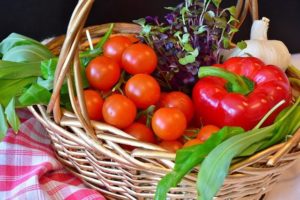For the past forty plus years, my diet has been predominantly plant-based. You may not be able see that from looking at my kitchen, with the exception of produce in the corner taking up acreage on my countertop. In order to keep them fresh, we have a wire basket packed with bananas, citrus fruits, avocados, melons and sometimes a small bag of fingerling potatoes. These are items that seem keep better at room temperature than storing them in the refrigerator, so they end up attractively taking up counter space.
It seems that many people are shifting toward eating more plants and less animal foods. Produce can be grown locally, eaten seasonally and is straight up a good way to eat more healthfully. As a result of this shift toward a plant heavier diet, kitchens may also be changing in order to make it easier to grow and store produce. Some trends that support this change include:
Micro farming in your home. My brother began growing herbs, lettuce and tomatoes in his small sun room a few years ago. In short order, he had way more food than he could eat and ended up giving much of it away to appreciative friends and family members. Growing your own produce at  home can be as simple as a couple of pots of your favorite herbs on the windowsill, growing sprouts or microgreens in a small place in your kitchen, or using starter gardening kit or system designed for small indoor spaces.
home can be as simple as a couple of pots of your favorite herbs on the windowsill, growing sprouts or microgreens in a small place in your kitchen, or using starter gardening kit or system designed for small indoor spaces.
Take it outside. Another option is to move your small garden outdoors. Lettuce, greens, tomatoes and other produce can easily thrive in pots on your patio. For something a little bigger, turn a patch of your lawn into food by creating a garden in a sunny spot.
Better longer. Back in the kitchen, products that extend the shelf life of your produce are beginning to appear on the market. In large scale, you can now find refrigerators that can be programmed with specific temperature and humidity controls to keep your produce better longer. You can also find food containers that will actually alert you when the food inside is going bad. To avoid science experiments of the worst kind, you can label your produce using tags that tell you when it was put in the refrigerator. And at the grocery store, you can now purchase produce with labels attached that emit a vapor which will extend the life of the item add deter the growth of mold.
vapor which will extend the life of the item add deter the growth of mold.
Turn food waste into more food. Many municipalities support a composting program with regular pickups. When we first began collecting food scraps for composting, it took a couple of stinky episodes before we arrived at a system that was clean and odor free. We ended up with a small, covered trash can under the sink specifically for compostable items. We’re lucky that our city has a weekly compost pick-up, so the scraps don’t linger. If your city doesn’t have a composting program and if you have a yard (we don’t) it’s fairly easy to compost in a bin, rotating drum, or pile outdoors. Just add some black dirt occasionally and turn the pile over, and voila! You have black gold for your garden or pots.
Let’s face it; many households are moving toward more sustainable, plant-based foods. Growing, storing and responsibly disposing of food waste isn’t a thing for the future. It’s here now, and it’s starting to change the layout and flow in our kitchens. And it may spill out into the sunroom, deck or your backyard garden in a way that makes it easier to eat fresh and healthy produce, no matter where you live.



